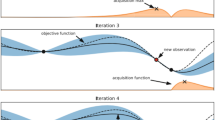Abstract
The hybridization of optimization techniques can exploit the strengths of different approaches and avoid their weaknesses. In this work we present a hybrid optimization algorithm based on the combination of Evolution Strategies (ES) and Locally Weighted Linear Regression (LWLR). In this hybrid a local algorithm (LWLR) proposes a new solution that is used by a global algorithm (ES) to produce new better solutions. This new hybrid is applied in solving an interesting and difficult problem in astronomy, the two-dimensional fitting of brightness profiles in galaxy images.
The use of standardized fitting functions is arguably the most powerful method for measuring the large-scale features (e.g. brightness distribution) and structure of galaxies, specifying parameters that can provide insight into the formation and evolution of galaxies. Here we employ the hybrid algorithm ES+LWLR to find models that describe the bi-dimensional brightness profiles for a set of optical galactic images. Models are created using two functions: de Vaucoleurs and exponential, which produce models that are expressed as sets of concentric generalized ellipses that represent the brightness profiles of the images.
The problem can be seen as an optimization problem because we need to minimize the difference between the flux from the model and the flux from the original optical image, following a normalized Euclidean distance. We solved this optimization problem using our hybrid algorithm ES+LWLR. We have obtained results for a set of 100 galaxies, showing that hybrid algorithm is very well suited to solve this problem.
Preview
Unable to display preview. Download preview PDF.
Similar content being viewed by others
References
Atkenson, C.G., Moore, A.W., Schaal, S.: Locally Weighted Learning. Artificial Intelligence Review 11, 11–73 (1997)
Back, T., Hammel, U., Schwefel, H.P.: Evolutionary Computation: Comments on the History and Current State. IEEE Transactions on Evolutionary Computation 1, 3–17 (1997)
Back, T., Fogel, D., Michalewicz, Z.: Handbook of Evolutionary Computation. Oxford University Press, London (1997)
Baggett, W.E., Baggett, S.M., Anderson, K.S.J.: Bulge-Disk Decomposition of 659 Spiral and Lenticular Galaxy Brightness Profiles. Astronomical Journal 116, 1626–1642 (1998)
Beyer, H.G.: Toward a Theory of Evolution Strategies: Self-Adaptation. Evolutionary Computation 3, 311–347 (1996)
de Vaucouleurs, G.: Recherches sur les Nebuleuses Extraglactiques. Ann. d’Astrophysics 11, 247 (1948)
Karttunen, H., Kroger, P., Oja, H., Poutanen, M., Donner, K.J.: Fundamental Astronomy. Springer, Heidelberg (2000)
Mitchell, M.: Machine Learning. McGraw-Hill, New York (1997)
Peng, C.Y., Ho, L.C., Impey, C.D., Rix, H.W.: Detailed Structural Decomposition of Galaxy Images. Astrophysical Journal 124, 266–293 (2002)
Rechenberg, I.: Evolutionsstrategie: Optimierung technischer Systeme nach Prinzipien der biologischen Evolution. Frommann-Holzboog, Stuttgart (1973)
Wadadekar, Y., Robbason, B., Kembhavi, A.: Two-dimensional Galaxy Image Decomposition. Astronomical Journal 117, 1219–1228 (1999)
Author information
Authors and Affiliations
Editor information
Rights and permissions
Copyright information
© 2007 Springer-Verlag Berlin Heidelberg
About this paper
Cite this paper
Gomez, J.C., Fuentes, O. (2007). A Hybrid Algorithm Based on Evolution Strategies and Instance-Based Learning, Used in Two-Dimensional Fitting of Brightness Profiles in Galaxy Images. In: Perner, P. (eds) Machine Learning and Data Mining in Pattern Recognition. MLDM 2007. Lecture Notes in Computer Science(), vol 4571. Springer, Berlin, Heidelberg. https://doi.org/10.1007/978-3-540-73499-4_54
Download citation
DOI: https://doi.org/10.1007/978-3-540-73499-4_54
Publisher Name: Springer, Berlin, Heidelberg
Print ISBN: 978-3-540-73498-7
Online ISBN: 978-3-540-73499-4
eBook Packages: Computer ScienceComputer Science (R0)




